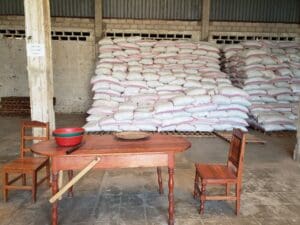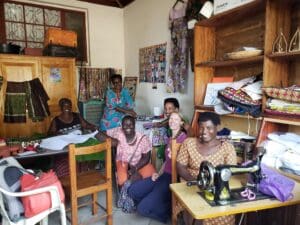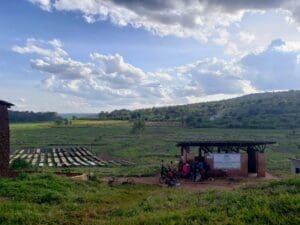Our last stop on our June 2023 Great Lakes tour was to visit longtime Burundi partner Kalico Link Company (Kalico), co-founded by coffee pioneer Angele Ciza, who sadly passed away this past year but left a strong family coffee legacy. One of Angele’s sons, Alexandre, has been heavily involved in Kalico for several years and is now running the company, which includes 7 large washing stations in 3 of Burundi’s 18 provinces. Organic coffee in Burundi is virtually non-existent, but Kalico will be RFA-certified later this year.
The coffee sector in Burundi has a complex history (For a deep dive, we did a Four-part Burundi Spotlight Series in 2019 when Burundi was the SCA Portrait Country at Expo.). Coffee was first brought to Burundi by the Belgian colonists in the 1930s, but, more recently, the civil war from 1993 to 2005 led to food insecurity and many turning away from coffee and toward cash crops. At that point, all washing stations were owned by the government; in 2009 the government opened up sales to private buyers, and many private companies purchased washing stations from ODECA, the coffee authority in Burundi that owned all the washing stations. While ODECA still owns about 100 washing stations and a large dry mill in Bujumbura, the private sector now processes around 70% of the country’s coffee production.
In 2020, Évariste Ndayishimiye was elected as President of Burundi. He is pro-business and coffee and working hard to maintain security and fight corruption. There’s a monthly meeting between ODECA and Burundian exporters where private exporters and the government can discuss challenges and offer solutions. Coffee is Burundi’s top export and—like coffee from adjacent DRC—plenty of commercial-grade Burundian coffee is smuggled and sold at Tanzanian coffee, so exporters are working hard to keep quality high so that consumers associate Burundian coffee with high-quality coffee.
We visited Kalico’s lab and cupped several washed, natural, and experimental process samples, and can heartily affirm that—at least in Kalico’s case—coffee quality is being maintained at a top level. Hops, peach and stonefruit, vanilla, floral, holiday spice, and black tea are all notes that came to mind when I cupped some of the samples.
While there is an auction for government coffee in Burundi, the majority of the country’s coffee is sold directly from private exporters to buyers. How cherry prices work in Burundi: early in the harvest, around Feb/March, ODECA will set the minimum price/kg of Cherry A (top quality) and Cherry B (floaters). As most coffee in the country is fully washed at central processing mills, when farmers deliver cherry at the washing stations, the floaters are returned to the farmer who can then sell them at the Cherry B price (roughly half the price of cherry A) or keep them and do home processing.
The government then sets the first closing date (this year was May 20th) whereby after that date, exporters then choose a day to pay farmers for all cherry delivered to the washing station from the first half of the harvest until that closing date. Farmers often will purchase cows and set up large markets, and the day is marked as a huge celebration due to the large lump sums that producers receive.
Fully washed, sorted Cherry A is specialty grade, whereas fully washed, unsorted Cherry A is ‘high’ commercial, and fully washed Cherry B is commercial grade. This year Atlas, to offer additional products from Kalico, purchased a small amount of ‘high’ commercial with Kalico, which was a vast over-delivery and is available at a great deal on our offer list.
Like Brazil and Rwanda, Burundi has a biennial harvest, with a ‘high year’ and a ‘low year.’ 2023 is in the ‘low year’ cycle and was particularly low this year due to climate change. In addition, while coffee often flowers in September, some are seeing flowering in December, indicating that perhaps some areas in Burundi will see a fly crop later this year.

Kalico's dry mill.
This year we visited CPC dry mill, one of two large dry mills in Bujumbura. During high season they will have up to 600 hand sorters in their facility. Kalico uses hand sorting, followed by UV light sorting for its specialty-grade coffee.
We then had the opportunity to visit Disyn Berna, the female-owned enterprise that employs six disabled women to sew and sell their handicrafts. They are also the women responsible for sewing the stunning “Kalico Mama” bag art fabric logos.

Photo of Disyn Berna. Bernadette (in the black tank top) leads the group and runs the program.
Kalico purchases from 15,000 farmers at seven washing stations and has 50 permanent staff and about 250 seasonal workers. Kalico hires farmers to work on model farms and then they take that practice back to their own farms as ‘lead farmers.’ Kalico has trained some of the women farmers on credit and savings groups.
In addition to the washing stations, Kalico has ‘Shamba,’ coffee from their own coffee farm plots. They currently have 40,000 trees and are planning 20,000 more in October, to have 150,000 trees. And this year, for the first time, they are trying very small amounts of 3 experimental processes, two of which we were able to cup. The first experimental process involves using a traditional pot (typically used to make sorghum beer) made by pygmies and called an Inkono pot. The process involves pulping, and then wet fermenting in the traditional pot. The second involves pulping, and doing wet fermentation with cherry skin on the top of the tank. The third involves fermenting whole cherries through wet fermentation for 24 hours and then straight to drying. Kalico is also doing some honey and natural processes at Hasura Washing station.
We visited Kalico’s largest washing station, called Murago, which was processing coffee that day. Their pulpers, similar to those used in Kenya, are depulped twice – the first pulping is calibrated to pulp larger beans, then a second pulper is calibrated to pulp the smaller beans. This ensures that, for a disk pulper, larger beans aren’t damaged in the depulping process. After pulping, the coffee has 14 hours of wet fermentation, washing, and grading into five grades (A1, 2, 3, 4, 5), then dried.

Kalico Coffee's Murago Washing Station.
Kalico uses not only the traditional paper method of receipts, but also a digital platform as a backup. As many farmers don’t have phones in the areas, mobile money payment isn’t possible, but this backup digital process allows farmers to not only be assured of their delivery volumes, but for Kalico to monitor the trends in washing stations.
More than ever, it feels like the time is ready for Burundian coffee to shine—and as Burundian coffee. Please reach out to your Atlas rep to receive a sample of our landed lots of Kalico.